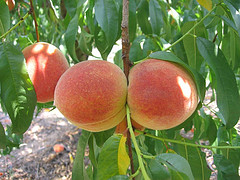Peaches
| Infobox on Peaches | |
|---|---|
| Example of Peaches |  |
| Freshness facts | |
| Optimum carrying temperature | 0°C; there being a wide range among cultivars (and growing seasons/periods) |
| Highest freezing point | -0,9°C |
| Acceptable product temp. at loading into containers | Max. 2°C above carrying temperature |
| Optimum humidity | 90%-95% |
| Ventilation setting for containers | 25 m³/hr |
| Storage life | 2-7 weeks |
| Climacteric / non-climacteric | Climacteric |
| Ethylene production | High |
| Ethylene sensitivity | High |
| Modified / controlled atmosphere | 3%-5% CO2; 1%-2% O2 |
| Potential benefits | Delayed ripening, firmness retention. A slight reduction in internal breakdown |
| Availability | |
| Australia/New Zealand South Africa South America |
December - March November - March December - March |
Peaches
Contents
Harvesting and handling
Peaches (and nectarines), are belonging to the stone fruit group, which have fleshy pulp containing a hard stone in the middle which encloses the seed. Stone fruits with a fully developed aroma and colour are not fit for export resp. overseas transport.
Botanically, nectarines and peaches differ in appearance, but the physiology of the fruits are much the same. Peaches and nectarines therefore react similarly during cold storage although different cultivars may respond differently during storage and transport.
With regard to disorders, stone fruits are subject to various types of injury and breakdown, influenced by cultivar, orchard and climatic factors, harvesting and handling practices and (pre-shipment) storage environment.
Maximum maturity is defined as the minimum flesh firmness (measured with a penetrometer with an 8-mm tip) at which fruit can be handled without bruising damage. Bruising susceptibility varies among cultivars.
All stone fruits are (particularly if not stored under adequate conditions) prone to serious post harvest decay, the most important being blue mould rot, grey mould rot and rhizopus rot, being the result of ‘soil borne and omnipresent’ fungi and bacteria. If stone fruit are stored for longer periods, they are subject to internal breakdown, loss of flavour, discolouration of the flesh, surface pitting, shrivelling, and predisposition to decay. Some of these disorders may not be apparent when the fruit is first removed from cold storage, but develop when the fruit is ripened. When completely ripe with a fully developed flavour and colour, peaches are very sensitive to mechanical influences. Only a few varieties are sufficiently robust to be able to withstand even relatively long periods of transport.
Cooling and storage
Maximum market life is obtained when fruit is stored at approximately 0°C. Maximum market life generally varies from 2-7 weeks for nectarine cultivars and from 2-5 weeks for peach cultivars. Cultural practices have an important role in determining fruit quality and storage potential. Storage of peaches and nectarines at 2°C to 5°C is especially bad as internal breakdown, which may be initiated at these temperatures in as little as 7 to 14 days, will develop during ripening.
Provided they are sufficiently mature when picked, this fruit can undergo softening and sweetening after harvest. Rapid cooling after harvest to temperatures below 4ºC (preferably to 0ºC) is important to retard respiratory activity, ripening and decay.
Inadequate cooling or excessively long storage may result in spoilage, loss of aroma, mealy-dry consistency and insipid flavour. If storage is excessively long, the fruit turns brown from the stone outwards, which is not evident from the outside. At 2 - 8°C, peaches (and nectarines) suffer "woolliness", a physiological disorder. The fruit becomes dry and mealy. Riper fruit have a lesser tendency to woolliness than do unripe fruit. Chilling damage may occur at temperatures of < 0°C, such damage primarily being manifested as:
- Breakdown: the fruits lose their natural clear colour, become dry and mealy and brown spots appear on the surface of the skin. In severe cases, the pulp around the stone becomes watery and may ultimately break down completely.
- Softness: on arrival at their destination, the peaches (and nectarines) have an abnormally high moisture content, while the pulp around the stone is unripe.
- Unripeness: if the temperatures during transport were too low or the fruit were picked too early, they no longer ripen properly at their destination.
Mixed loads
Peaches (and nectarines) should not be shipped with ethylene-generating or ethylene-sensitive commodities
Cautions
O2 below 1% can cause off-flavours in fruit destined to be canned. CO2 greater than 5% may cause flesh browning. Peaches (and nectarines) should be kept near 0°C because at 4°C to 8°C they are likely to develop internal breakdown and above 10°C they will ripen rapidly and decay will develop.
Storage disorders
Alternaria rot, Anthracnose, Bacterial black spot, Blue mould, Brown rot, Bruising, Cladosporium rot, Cracking, Freezing injury, Grey mould rot, Insect damage, Internal breakdown, Mosaic virus, Powdery mildew, Pustular spot, Rhizopus rot, Rust, Scab, Sour rot.











